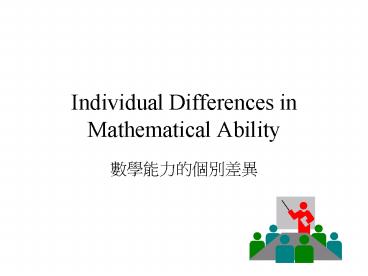Individual Differences in Mathematical Ability PowerPoint PPT Presentation
1 / 21
Title: Individual Differences in Mathematical Ability
1
Individual Differences in Mathematical Ability
- ?????????
2
Three Perspectives
- Psychometric
- Cognitive
- Behavioral
3
Psychometric Perspective
- Method used Factor Analysis
- Results Ability Factors
- Criterion Factor stability or factor invariance
-- the factor represents a basic domain of human
ability, distinct from other cognitive abilities
for educational, cultural, or biological reasons.
- Two general mathemttical domains numerical
facility and mathematical reasoning
4
Numerical Facility
- Stable across studies arithmetic represents a
fundamental domain of human ability - strongly defined by arithmetic computation tests
tests that involve a conceptual understanding of
number relationships and arithmetical concepts -
basic arithmetical skills
5
- Development Numerical Facility factor found in
- kindergarten children (Wechsler Intelligence
Scale for Children WISC) - 5 - 7 years of age also demonstrate (Meyers and
Dingman 1960) - samples of children, adolescents in elementary
schools, junior high school, high school, and
college
6
- The factor becomes more exclusively arithmetical
in nature with development. - Arithmetic and working memory to exclusively
arithmetical - relationship between performance on numerical
facility tests and tests of mathematical
reasoning become weaker with age.
7
Mathematical Reasoning
- Different labels arithmetical reasoning, general
reasoning, - ability to find and evaluate quantitative
relationships and to draw conclusions on the
basis of quantitative information - Relationship between Numerical Facility and
Mathematical Reasoning factors become weaker with
age.
8
- 8th grade the two factors clustered
- grades 9 to 11 and college students distinct
Mathematical Reasoning - college students the 2 unrelated.
9
Other Mathematical Abilities
- Dot Counting Factor ability to quickly and
accurately count arrays of dots. - Digital Flexibility ability to manipulate, to
arrange, and to compare (numbers), without
performing arithmetic operations, e.g., making
rapid greater than or less than comparisons of
sets of numbers. - Estimation Factor ability to make quantitative
estimations ability to create and evaluate new
hypothesis quickly in order to draw proper
conclusions
10
????
- ??????????(Information Processing Model) ???,
???5?????????, ??????, ?????? (?? ??, ??)
11
Cognitive Perspectives
Retrieving arithmetic facts from long-term memory
Numerical Facility
Memory span
Mathematical Ability
Mathematical Reasoning
Mental calculation ability
..
Psychometric
Cognitive
12
Numerical Facility
- A battery of Paper-and-pencil Test
- numerical facility,
- perceptual speed (i.e., speed of encoding, or
reading symbols such as numbers - spatial ability
- Computer-administered arithmetic test
- number encoding (reading numbers off the computer
screen - retrieving arithmetic facts from long-term
memory, - carrying (or trading)
- Time required for each component process is
recorded
13
Relationship between Numerical Facility and
Cognitive Abilities
- The faster arithmetic facts could be retrieved
from long-term memory and the faster the carry
(or trade) operation could be executed, the
better the performance on the paper-and -pencil
numerical facility tests. - Speed of executing these arithmetical processes
was not directly related to performance on the
perceptual speed and spatial tests.
14
Implications
- Basic arithmetic skills underlying individual
differences (agreed with psychometricians) - numerical facility is arithmetical in nature.
15
Other Studies (Geary Brown, 1991, )
Two variables
Arith
Spacial
Arith
Conceptual Knowledge
Working memory
16
Developmental Issues
- Preschool and elementary school children
conceptual knowledge and working memory appear to
be a primary source of individual differences in
arithmetic ability. - As basic facts become committed to memory and
procedures become automatic, speed with basic
arithmetical processes such as carrying or
trading become the major source.
17
Mathematical Reasoning
For 112 Air Force recruits
- Battery of psychometric tests include
- Numerical facility,
- Perceptual Speed,
- Mathematical Reasoning (General Reasoning), 2
sets of arithmetic-word-problem tests - actually solve the problem
- determine the sequence of arithmetic operations
- Memory Span factors
- Cognitive measures
- speed of executing arithmetical operations such
as carrying - ability to perform arithmetical operations in
working memory
80
25
18
Individual Differences in Mathematical Reasoning
- Ability to mentally set up representations of
arithmetic word problems - the ease with problem-solving schemas are
developed - working memory, the ability to keep important
information in mind while performing mathematical
operations - speed with which basic mathematical processes can
be executed
19
Behavioral Genetic Perspective
- heritability h2 estimate of the amount of
variability in a particular trait for a given
population that is due to individual differences
in the constellation of genes that support the
trait. - 2 common methods
- comparing between sets of identical or
monozygotic (MZ) twins and fraternal or dizygotic
(DZ) twins - familial resemblance studies the extent to which
parents and children are similar on a given trait.
20
Numerical Facility
- Median h2 across several studies .45 Vandenbery
(1966) - individual numerical facility tests such as
addition .43 - .58 Vandenbery (1962) - elementary grades in arithmetic .66 (Husen)
- arithmetical skills of parents and children ve
correlated (DeFries) - one half of the variability in arithmetical
ability is due to genetic factors.
21
Mathematical Reasoning
- h2.27 across several studies (Vandenberg)
- MZ and DZ h2 .36 to .66
- a small to moderate proportion of individual
differences in mathematical reasoning ability are
due to genetic factors.

